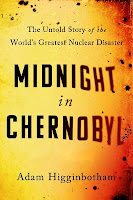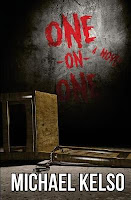Midnight in Chernobyl by Adam Higginbotham
Author : Adam Higginbotham
Title : Midnight in Chernobyl
Published : 2019
Publisher : Simon & Schuster Inc
Pages : 560
Genre : Non Fiction
Early in the morning of April 26, 1986, Reactor Number Four of the Chernobyl Atomic Energy Station exploded, triggering history's worst nuclear disaster. In the thirty years since then, Chernobyl has become lodged in the collective nightmares of the world: shorthand for the spectral horrors of radiation poisoning, for a dangerous technology slipping its leash, for ecological fragility, and for what can happen when a dishonest and careless state endangers not only its own citizens but all of humanity. But the real story of the accident, clouded from the beginning by secrecy, propaganda, and misinformation, has long remained in dispute. Drawing on hundreds of hours of interviews conducted over the course of more than ten years, as well as letters, unpublished memoirs, and documents from recently-declassified archives.
While I was alive when reactor number four explode, I was far too young to have any conscious memories or thoughts about it. Over the years there have been a few programs scattered across different t.v channels about the disaster and my parents have said a few bits and pieces about things that came up on the news at the time. But the whole truth all ways seemed to be just out of sight. It is one of those stories that desperately wants to be told but no one would seem overly willing to set out all the facts from start to finish. You get the feeling that none more than the Russian government wants this whole episode to be forgotten and left in the annals of history to be forgotten. And I guess to some extent they are getting this wish, The name Chernobyl is starting to mean less and less with each generation. For those who have sought out its secrets more than thirty years later, it would have appeared to have become a dark Disneyland a place to go and gork at a city abandoned to the wilds of mother nature. So when I saw it come up on my Goodreads feed I thought this might be the book to give me a better understanding of what really caused reactor four to explode.
While it is true that this is the story of one of the most horrific nuclear accidents in history this is not the author starting point. He begins with a small village of farmers in a place far from most other signs of civilization. The perfect place to set out the governments vision of the future. The best and the brightest of everything and at its heart a state of the art nuclear facility to run everything. I suppose at the time it was a noble ambition, but with all such things corners get cut and the pressure put on the people expected to build and run such place all becomes too much. With this story, it is just as much about the physical problems of the plant as much as it is a study into the people who were trying to create something. He looks into the lives of each of the key players from the people who worked the lowest levels of the plant to the top officials who wanted Chernobyl to an example of everything Russia could achieve, and in turn went on to do there best to at first cover up what took place and then went on to lie to the world about how bad it had been. Scattered throughout there author gives us a rudimentary lesson in how the nuclear plant operated. this essentially allowed me to understand the role of each of the workers he talked about and how each would interact with the plant.
The book is well laid out from the first few pages that gave me the names of those whose lives I would come to learn about and also where the plant its self and the city where and that of there layout. I have to say I wasn't entirely sure of the latter before picking up this book. He has done a great job of giving a human face to this disaster. I suppose it is all too easy to see this as something that happened in the distant past. But at the time this was an event that rocked the world, it would go one to shape the use of nuclear power for civilian use the world over. The radioactive dust that erupted into the air on that fatal night floated back down to earth very far from where it had first started. It would also be fair to say that the author tries his best to give a nonbiased view as to what took place. It would be so easy to blame the men who were stationed in the control room on that night. But as much as they are to blame this was just as much caused by men in offices hundreds of miles away. The after mouth of what took place was a storm of lies and cover-ups. The people who lived there but also those where sent in to not only investigate but also clean up where some of the biggest victims of this, never being told what they were putting there lives on the line for.
The book finishes up with a look into the plant in two thousand and sixteen. How the world has moved on from this and while some lessons have been learned others seemed to be destined to be repeated. As someone who had very little working knowledge of what took place this book gave me all that I was looking for. It moves along at a steady pace without getting to hung up on any specific area. Giving a human face and feeling to the accident whilst teaching about the scrabble for blame and those who fought to not only save those they could but also to get the truth out it's just a shame it took so long. Just maybe others had could have been saved if just once the government in charge of the incident had been a little more honest.



Comments
Post a Comment